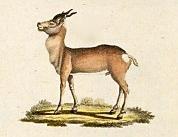Procapra
In this article we will explore Procapra from different perspectives, with the aim of offering a complete and enriching analysis of this topic. We will delve into its origins, evolution and relevance today, as well as its possible implications and applications in various fields. Through research and reflection, we seek to provide the reader with a broad and detailed vision of Procapra, inviting them to immerse themselves in its study and understanding from different angles. Without a doubt, this is an extremely interesting and constantly developing topic, from which countless reflections and interpretations will emerge that will enrich our understanding of it.
| Procapra | |
|---|---|

| |
| Mongolian gazelle Procapra gutturosa | |
| Scientific classification | |
| Domain: | Eukaryota |
| Kingdom: | Animalia |
| Phylum: | Chordata |
| Class: | Mammalia |
| Order: | Artiodactyla |
| Family: | Bovidae |
| Subfamily: | Antilopinae |
| Tribe: | Antilopini |
| Genus: | Procapra Hodgson, 1846 |
| Type species | |
| Procapra picticaudata Hodgson, 1846
| |
| Species | |
|
P. gutturosa | |
Procapra is a genus of Asian gazelles, including three living species:
- Mongolian gazelle P. gutturosa
- Tibetan gazelle P. picticaudata
- Przewalski's gazelle P. przewalskii
The oldest fossils belonging to the genus Procapra date from the late Pliocene or early Pleistocene of central Asia, when the climate was wetter and milder than now. The genus apparently evolved from animals similar to the Pliocene gazelle Gazella sinensis, and is known to have been hunted by early Neolithic humans at Lake Qinghai in China.
References
- ^ Groves, C. P. (1967) On the gazelles of the genus Procapra Hodgson, 1846. Z. Saugetierk. Accessed on 2008-05-31 PDF Archived 2008-07-27 at the Wayback Machine
- ^ Myers, P., R. Espinosa, C. S. Parr, T. Jones, G. S. Hammond, and T. A. Dewey. 2008. The Animal Diversity Web (online). Accessed May 31, 2008 at http://animaldiversity.org
- ^ Leslie, D.M. Jr. (2010). "Procapra picticaudata (Artiodactyla: Bovidae)". Mammalian Species. 42 (1): 138–148. doi:10.1644/861.1. [dead link]
- ^ Rhode, D.; et al. (2006). "Epipaleolithic/early Neolithic settlements at Qinghai Lake, western China". Journal of Archaeological Science. 34 (4): 600–612. doi:10.1016/j.jas.2006.06.016.